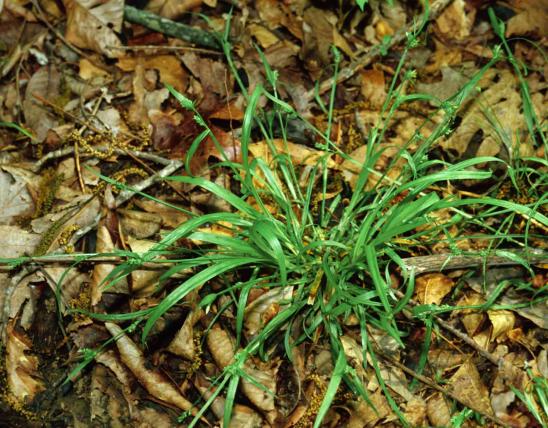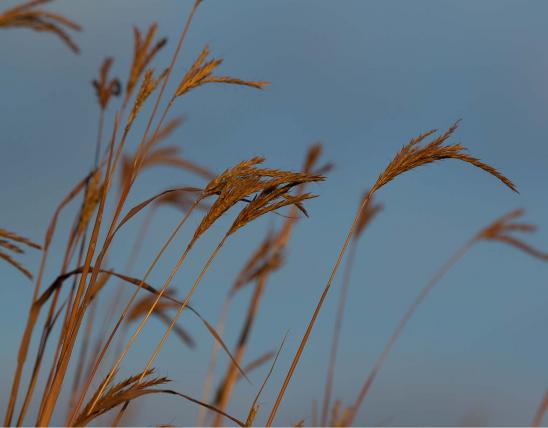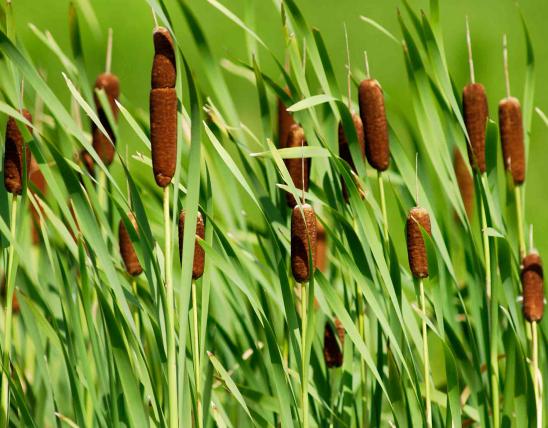
Rushes are mostly perennial, nonwoody plants. Stems are round in cross-section but not hollow. Leaves are alternate or all basal, grasslike or tubular, and expanded at the base into open or closed sheaths around the stems. Leaves of genus Juncus lack hairs; those of genus Luzula have hairs. Flowers have 3 sepals that are green or tan, and 3 petals that resemble the sepals. Each flower has 1 ovary, which matures into a capsule, round in cross-section, that splits apart lengthwise into 3 sections when mature. Each capsule can hold 3 (genus Luzula) or many (genus Juncus) seeds.
Missouri has 23 species in the genus Juncus and 1 species (with 3 subspecies) in the genus Luzula. Identifying the various species of rushes can be difficult. You usually need to view the mature fruit capsules under magnification, and observe whether the individual flowers are closely subtended by a pair of short bracts, as opposed to scattered small bracts, in order to key them out.
Key Characters: Plants in the rush family typically have
- Leaves basal
- Stems round, solid
- Flowers with 3 sepals and 3 sepal-like petals
- Many-seeded capsules that split open lengthwise into 3 sections.
Similar species: Grass family plants differ by having hollow stems, 2-ranked leaves, highly specialized flowers that lack apparent petals and sepals, and fruits that are grains. Sedge family plants have triangular stems, 3-ranked leaves with closed sheaths, flowers enclosed by scalelike bracts but no petals or sepals, and nutlike fruits called achenes.
People often think of rushes (Juncaceae), sedges (family Cyperaceae), and grasses (Poaceae) as a single, confusing graminoid (grasslike) group. To help you remember, here’s one version of the famous rhyme: “Sedges have edges / Rushes are round / Grasses are hollow with nodes — Which have you found?”
Height: some species can be over 4 feet tall; most are shorter.

Statewide. Some species are fairly widespread and common. Others are rare or limited to certain parts of the state.
Habitat and Conservation
Of the two genera in Missouri, Juncus species usually occur in wetlands or other moist habitats. Luzula (wood rush) species are usually associated with drier land, and our one species is no exception. As with grasses and sedges, rushes can be tricky to identify to species. Botanists examine details of mature fruits and the bracts beneath the little flowers to key out specimens. The spongy tissue in the center of rush and sedge stalks permits air to reach the roots of these often aquatic plants.
Status
Missouri has 23 species in the genus Juncus and 1 species (with 3 subspecies) in the genus Luzula. Three of the Juncus species are known only from historical records but might still be rediscovered in the state. Five more are state-listed as critically imperiled.
Human Connections
The aboveground portions of rushes are good forage for livestock as well as for many kinds of native grazing mammals, including deer.
The rapid and lush growth of many types of rushes make them useful for preventing erosion, stabilizing stream banks, absorbing rain runoff in water gardens, and purifying water in wastewater treatment and biofiltration projects.
Globally, rushes have been woven into mats and baskets, spun into string, and scattered on earthen floors as a floor covering. The famous tatami mats traditionally used as a floor covering in Japan are made from a type of rush — soft rush, Juncus effusus — wrapped around a core of rice straw.
You may have heard of rushlights, especially if you’re a fan of English literature. For centuries in England, rushlights were a popular, cheap alternative to candles back when beeswax candles or oil lamps were too expensive to burn for nightly use. Rushlights were basically free to make: you took a rush stalk (available in almost any ditch), peeled away all but a thin strip of the outer skin (needed to provide structural support), then allowed the remaining stick of pith to dry. Then, you soaked it in animal grease or tallow (fats left over from cooking), removed it, and allowed it to cool and harden. Lit at the tip, it gave off light comparable to that of a candle. Brightness and burn time varied with technique and type of fats used. Children could be taught to gather and peel the stalks and to make rushlights for the home. Rushlights were used in England until the late 1800s and were also used in that country during the privations of World War II.
Ecosystem Connections
Rushes are important members of many prairie and wetland communities. Most are good for erosion control and some are effective colonizers of disturbed habitats. The seeds, rootstocks, and foliage provide food for many kinds of animals.








































